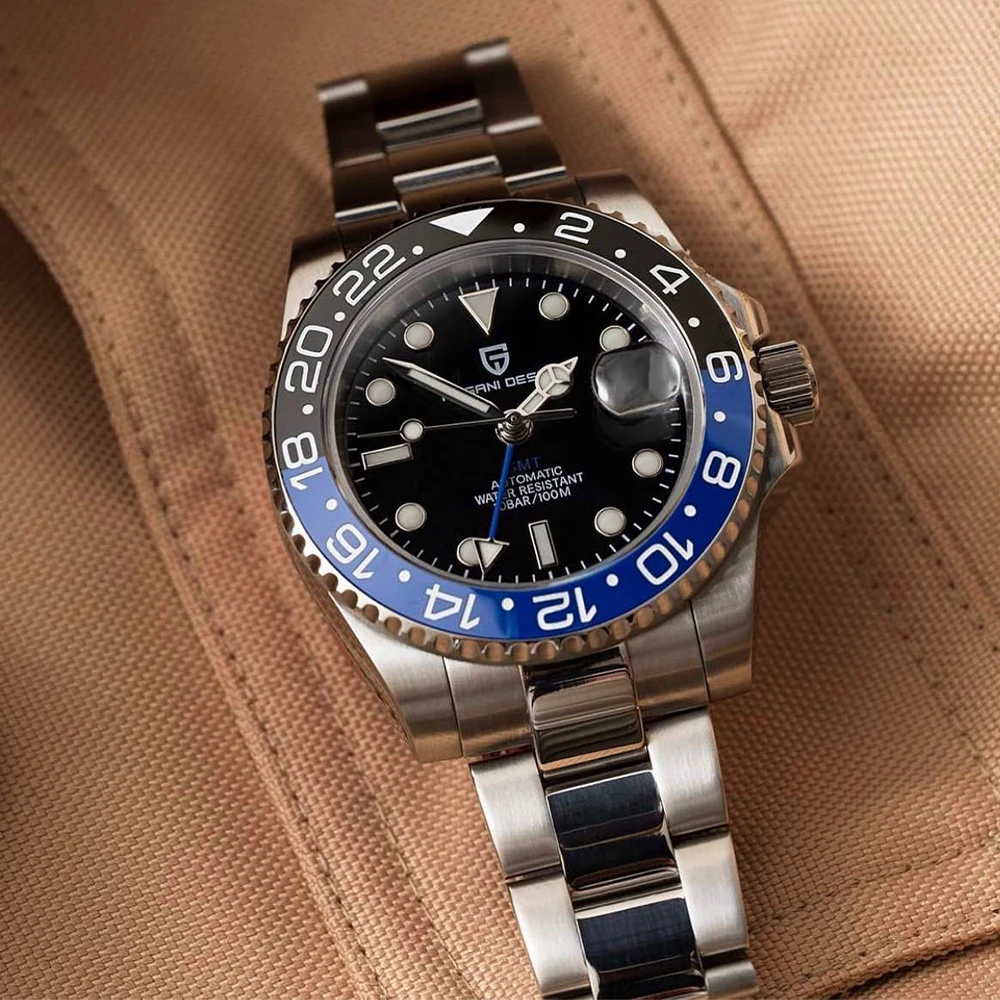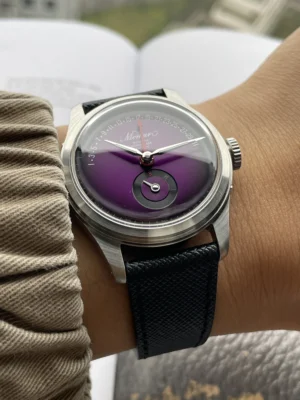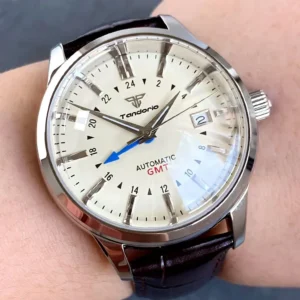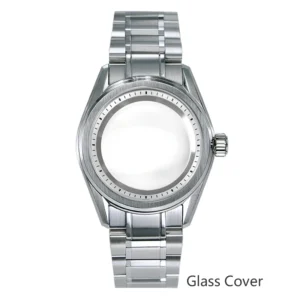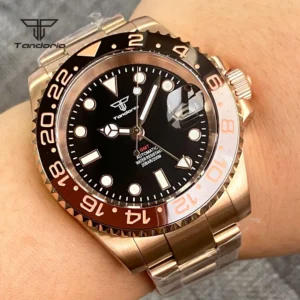What are GMT and World Time Watches? Key Definitions
In the fascinating world of horology, watches that track multiple time zones stand as marvels of engineering and practicality. These specialized timepieces have become essential tools for travelers, business professionals, and watch enthusiasts alike.
GMT watches feature an additional 24-hour hand that completes one rotation per day, allowing wearers to track a second time zone simultaneously. This extra hand points to a dedicated 24-hour scale, typically found on the bezel or dial. Originally designed for pilots navigating across different time zones, GMT watches offer a straightforward solution for tracking two locations at once.
World Time watches represent a more complex approach, displaying all 24 major time zones simultaneously. These timepieces feature a rotating city disc or ring with names representing different time zones, paired with a 24-hour indicator. At a glance, the wearer can determine the current time anywhere in the world—a remarkable feat of mechanical ingenuity.
The development of these specialized watches follows a tradition of creating history-dive watch engineering solutions for specific professional needs. The standardization of global time zones at the 1884 International Meridian Conference created the foundation for these complications, which watchmakers soon transformed into wearable tools.
In watchmaking terminology, these time zone features are known as “complications”—any function beyond simple time-telling. Both GMT and World Time complications serve the same fundamental purpose: helping users navigate our global world with greater ease, whether for business, travel, or staying connected with loved ones abroad.
For those specifically interested in exploring GMT options, our collection of GMT automatic watches showcases how this practical complication can be implemented with different designs and approaches.
The Evolution and Function of GMT Watches
The GMT watch concept emerged directly from aviation needs in the mid-20th century. As commercial air travel expanded and flights began crossing multiple time zones, pilots needed a reliable way to track both their departure time zone and Greenwich Mean Time (GMT)—the universal aviation standard.
The defining feature of a GMT watch is its additional 24-hour hand. Unlike the standard hour hand that rotates twice daily, this specialized hand completes just one full rotation every 24 hours, aligning with a 24-hour scale. This deliberate design eliminates any confusion between AM and PM hours in the second time zone.
GMT watch movements fall into two distinct categories that affect their functionality:
“True GMT” movements allow independent adjustment of the local hour hand while the 24-hour hand maintains its original setting. This feature proves invaluable when traveling, as you can easily adjust to local time without disrupting your reference to home time.
“Caller GMT” movements (sometimes called “office GMT”) link the standard hour hand and 24-hour hand, requiring a more complex adjustment process when changing time zones.
Many GMT watches feature rotating bezels marked with 24-hour scales, adding versatility to their function. By rotating this bezel, wearers can effectively track a third time zone—a feature particularly useful for those working with teams across multiple countries.
The technical evolution of these timepieces parallels other specialized watch developments, as seen in the evolution of dive watch technology, where form follows function to address specific professional needs.
The beauty of the GMT design lies in its straightforward approach to a complex problem: how to simultaneously track time in different parts of the world using purely mechanical means. This elegant solution has made GMT watches enduringly popular with frequent travelers, multinational business professionals, and watch collectors alike.
Reading and Setting a GMT Watch: Practical Guide
Using a GMT watch effectively requires understanding its unique features and how they work together. Here’s how to get the most from this practical complication:
Reading your GMT watch:
- The standard hour and minute hands show your local time just like any regular watch
- The additional GMT hand (often colored differently) points to the 24-hour scale, showing your reference or “home” time
- If your watch has a rotating bezel with 24-hour markings, it can be used to track a third time zone
Setting your GMT watch correctly:
- First, set your local time using the main hour and minute hands
- Then, set the GMT hand to point to your reference time zone on the 24-hour scale
- If using the bezel for a third time zone, rotate it to align with the appropriate offset from your GMT hand
A key advantage of the GMT hand’s 24-hour cycle is the clear distinction between AM and PM hours. When the GMT hand points between 1 and 12 on the 24-hour scale, it’s daytime hours; between 13 and 24, it’s nighttime hours in that time zone.
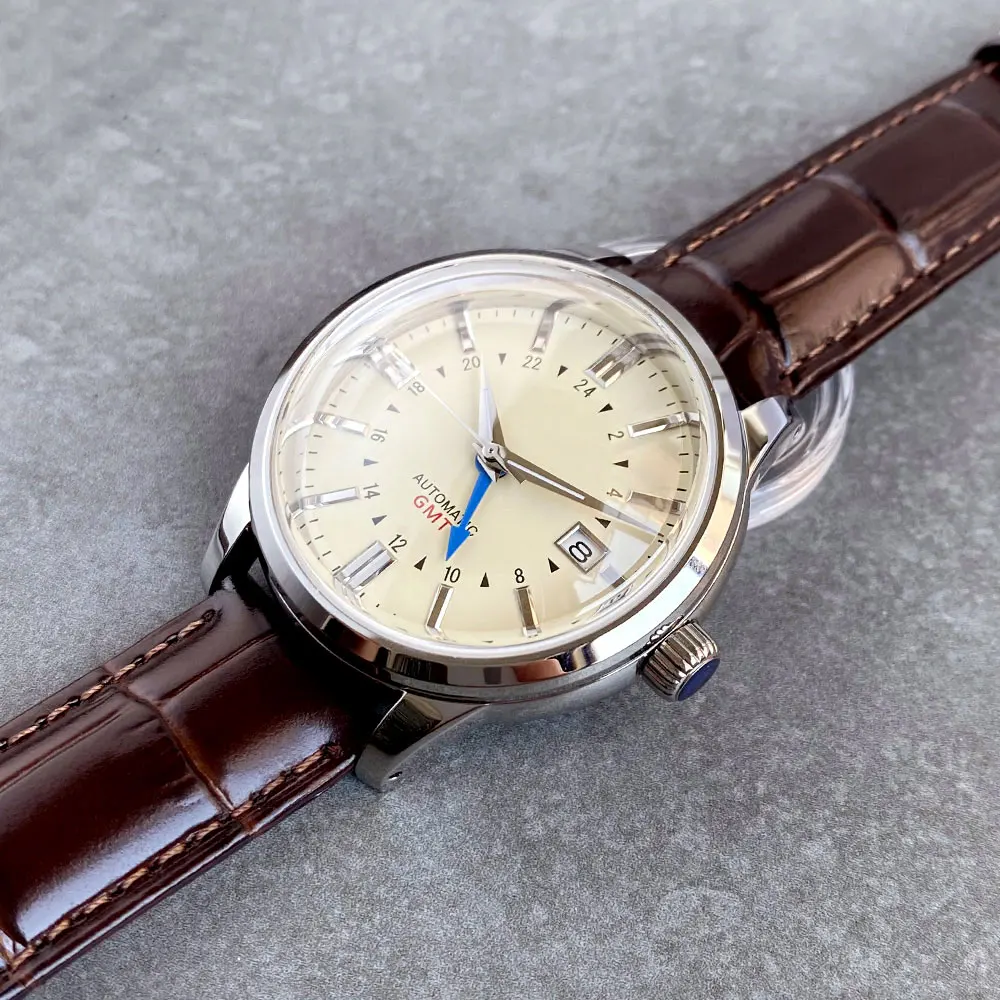
Common mistakes to avoid:
- Confusing the GMT hand with the minute hand (look for the distinctive color or arrow tip)
- Forgetting that the GMT hand moves at half the speed of the regular hour hand
- Incorrectly calculating time differences when setting the watch
For those interested in the aviation heritage behind these timepieces, exploring our GMT pilot watches collection provides insight into how these functional tools have evolved while maintaining their core purpose.
World Time Watches: Complex Engineering Made Accessible
World Time watches represent one of watchmaking’s most impressive mechanical achievements—displaying all major time zones simultaneously in an elegant, readable format. The genius behind this complication is credited to Swiss watchmaker Louis Cottier, who developed the first practical world time mechanism in the 1930s.
At the heart of a world time watch are three key components working in perfect harmony:
- A city ring/disc displaying 24 major cities, each representing a different time zone around the globe
- A 24-hour ring/disc that makes one complete rotation every 24 hours
- Standard hour and minute hands showing the local time
The mechanical orchestration is remarkable: as the watch runs, the 24-hour disc rotates continuously, while the city ring remains stationary (unless adjusted). By aligning your current location at the 12 o’clock position, the entire system synchronizes—allowing you to read the time in any other city by simply looking at where its name aligns with the 24-hour disc.
This complex mechanism requires significantly more components than a standard GMT watch, with dozens of additional parts working in precise coordination. The synchronization of these elements represents the pinnacle of mechanical watchmaking, packing global time awareness into the confined space of a wristwatch.
The world timer’s development parallels other sophisticated complications in watchmaking history, requiring watchmakers to solve multiple technical challenges simultaneously. For those interested in understanding different approaches to time zone tracking, our ultimate guide to GMT functions in tool watches provides valuable context.
What makes world time watches particularly impressive is how they transform mechanical complexity into user simplicity—displaying vast amounts of information in a way that’s intuitive to read and visually compelling.
Setting and Reading a World Time Watch
Despite their complexity, world time watches are designed for straightforward operation once you understand the basic principles:
Setting your world time watch:
- Identify your current location on the city ring
- Set the watch so this city name is positioned at 12 o’clock (usually using a dedicated pusher or crown)
- Set the main hands to your current local time
- The watch is now synchronized—all 24 time zones can be read simultaneously
Reading time around the world:
- Read your local time using the main hour and minute hands
- To find the time in another city, locate its name on the city ring
- Look at where that city aligns with the 24-hour ring to determine the current time there
- The 24-hour format eliminates AM/PM confusion
World time watches typically represent each time zone with a major city, but this creates some limitations. Not all locations follow exact hour differences—some operate on half-hour or even quarter-hour offsets from GMT. Additionally, seasonal time changes like Daylight Saving Time require manual adjustment, as mechanical world timers cannot automatically account for these variations.
For travelers crossing the International Date Line, an additional mental calculation is needed, as the watch displays time but not the date difference.
Those interested in more specialized timezone functions might find valuable information in our guide on mastering timezone complications in pilot and travel watches, which explores additional approaches to this horological challenge.
Who Should Choose a GMT Watch? Ideal Users and Scenarios
GMT watches shine in their focused practicality for specific use cases and travelers. Here’s who might benefit most from this timepiece:
Ideal GMT watch users:
- Frequent travelers between two specific locations (like business commuters between London and New York)
- Professionals who regularly communicate with one international office or team
- People maintaining connections with family or friends in a specific overseas location
- Those who prefer straightforward functionality and clean dial layouts
The GMT watch particularly excels in scenarios requiring constant awareness of time in two locations without needing the full global picture. For example:
- An executive who needs to know when colleagues at headquarters are available while traveling abroad
- Family members with loved ones overseas, wanting to avoid calling at inconvenient hours
- Pilots tracking departure time and destination time during long-haul flights
- Investors monitoring markets in two different regions

GMT watches also tend to be more versatile in their design, often incorporating other useful features. Our collection of GMT dive watches demonstrates how this functionality can be combined with diving capabilities for truly versatile timepieces.
The appeal of GMT watches often lies in their balance of functionality and wearability—offering practical time zone tracking without overwhelming the wearer with information or requiring complex interactions.
Who Should Choose a World Time Watch? Ideal Users and Scenarios
World time watches cater to a different user profile—those needing a comprehensive global perspective rather than focused tracking of specific locations:
Ideal world time watch users:
- Global business leaders coordinating across multiple international offices
- Frequent international travelers visiting numerous countries in short timeframes
- Diplomats, foreign service officers, or international organization staff
- Investment professionals monitoring markets across Asia, Europe, and the Americas
- Watch collectors who appreciate technical complexity and horological artistry
These timepieces excel in scenarios requiring simultaneous awareness of multiple time zones:
- Conference calls involving participants from several countries
- Planning a multi-stop international trip across several continents
- Global event coordination spanning numerous time zones
- Investment decisions based on market openings and closings worldwide
World time watches also hold special appeal for horology enthusiasts who appreciate mechanical complexity. These watches represent a technical achievement in watchmaking, packing extraordinary functionality into a wrist-worn format. The visual appeal of their distinctive dials—often featuring world maps or intricate city rings—makes them conversation pieces and objects of admiration.
When considering the investment in such a complex timepiece, understanding how long automatic watches last becomes particularly relevant, as these sophisticated complications represent significant value and craftsmanship.
Head-to-Head Comparison: GMT vs. World Time Watches
When comparing these two approaches to multi-timezone tracking, several key factors emerge:
| Feature | GMT Watches | World Time Watches |
|---|---|---|
| Time zones displayed | 2-3 zones | All 24 major zones simultaneously |
| Mechanism complexity | Moderate | High (many more components) |
| Dial legibility | Generally high | Can be busier with more information |
| Typical price range | More accessible | Premium (due to complexity) |
| Setting ease | Straightforward | Requires more understanding |
| Size considerations | Can be more compact | Often larger to accommodate mechanism |
| At-a-glance readability | Excellent for tracked zones | Complete global perspective |
| Typical user | Focused traveler | Global traveler/coordinator |
GMT watches excel in simplicity and directness—they do one job extremely well. They provide clear information about specific time zones without overwhelming the wearer with unnecessary data. Their more straightforward construction typically makes them more affordable entry points into multi-timezone watches.
World time watches, conversely, provide comprehensive global coverage at the expense of some simplicity. They represent horological achievements, showcasing the watchmaker’s ability to solve complex mechanical challenges while creating functional tools.
For those exploring different multi-timezone options, our guide comparing GMT vs. dual time watches offers additional insights into the various approaches watchmakers take to address this common need.
Design and Aesthetic Considerations
The functional requirements of GMT and world time complications dramatically influence their visual presentation, creating distinctive aesthetic signatures for each watch type.
GMT watches typically maintain a cleaner, more restrained appearance. The additional GMT hand—often brightly colored for visibility—and a 24-hour scale are the only major additions to a standard watch face. This allows GMT watches to maintain versatility in design, from sporty models with rotating bezels to elegant dress watches with subtle second time zone indicators.
World time watches, by necessity, feature more visually complex dials. The city ring displaying 24 locations and the corresponding 24-hour disc require significant dial space, creating a busier but information-rich presentation. Designers must carefully balance legibility with aesthetic appeal, often employing color coding, varying textures, or concentric circles to organize the wealth of information.
Case dimensions are similarly affected by these different approaches. GMT mechanisms add minimal bulk to a standard movement, allowing for thinner profiles. World time mechanisms, with their additional discs, gears, and synchronization systems, typically require larger case dimensions to accommodate the complex mechanics within.
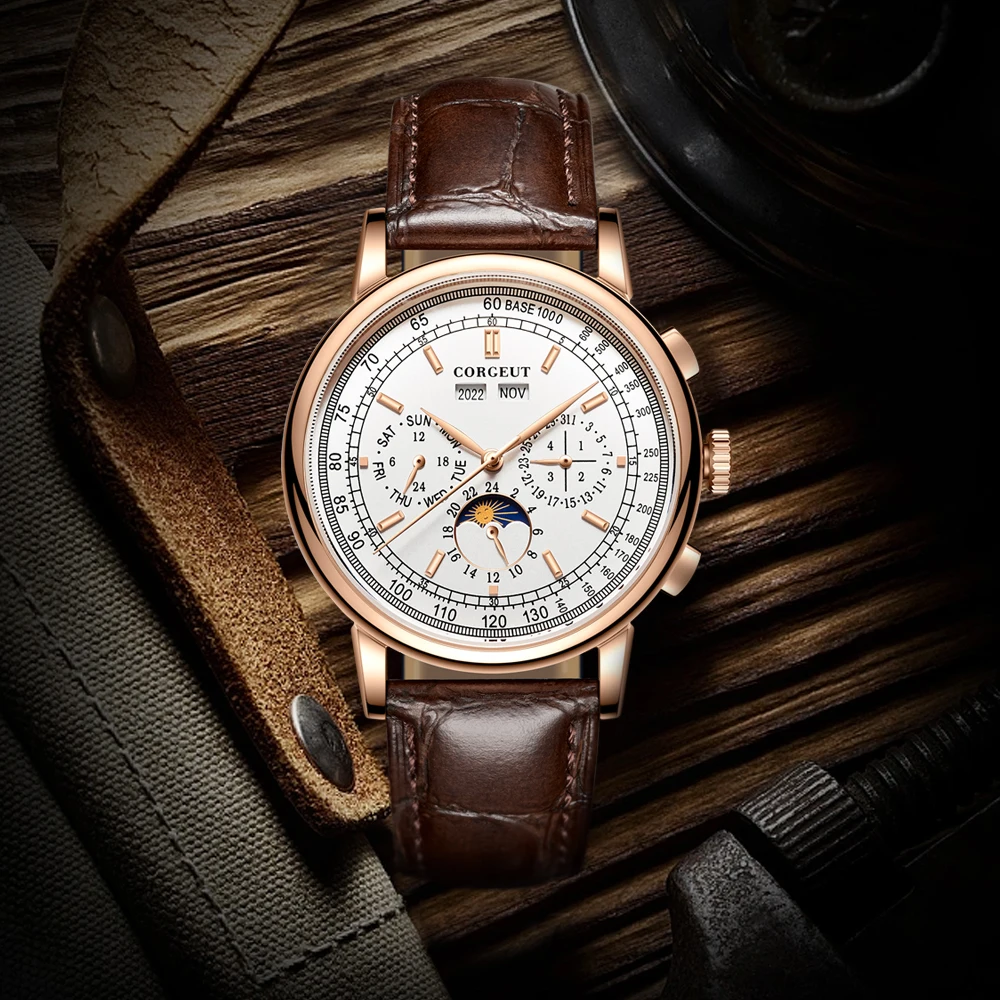
The visual character of each complication creates distinct wrist presence. GMT watches often project purposeful utility, while world time watches tend to convey horological sophistication. For collectors interested in mechanical complexity beyond time zones, our perpetual calendar automatic watches represent another pinnacle of watchmaking achievement.
Modern Innovations: Blurring the Traditional Lines
Contemporary watchmaking has increasingly blurred the traditional boundaries between GMT and world time complications, creating innovative hybrid approaches that combine elements of both.
Some modern designs feature GMT-style additional hands while incorporating city discs for easier zone identification. Others use digital displays for world time functions while maintaining traditional analog displays for local time. These hybrid approaches aim to capture the best of both worlds: the simplicity of GMT watches with the comprehensive coverage of world timers.
Recent innovations include:
- Watches with multiple independently adjustable hour hands
- Digital world time displays with physically rotating city rings
- Simplified city indicators that display key locations without overwhelming the dial
- Quickset pushers that instantly jump between major city time zones
- Streamlined world time mechanisms that maintain the functionality while reducing case thickness
Smartwatches have also revolutionized the multi-timezone landscape, offering programmable displays that can switch between GMT-style simplicity and full world time information as needed, though they lack the mechanical ingenuity that makes traditional complications so appealing to enthusiasts.
Despite these innovations, the fundamental approaches pioneered decades ago remain remarkably relevant, speaking to the enduring brilliance of their original design concepts.
Making Your Choice: Practical Considerations and Questions
When deciding between a GMT and world time watch, consider these questions to guide your choice:
How many time zones do you regularly track?
* Just one or two specific locations? A GMT watch likely meets your needs.
* Multiple zones across different continents? A world time watch offers comprehensive coverage.
Do your tracked time zones remain consistent?
* If you repeatedly check the same locations, a GMT watch provides focused efficiency.
* If you need different locations depending on the situation, a world time watch offers flexibility.
How important is dial simplicity?
* Prefer minimal information and clean aesthetics? GMT watches typically offer clearer dials.
* Enjoy information-rich displays and mechanical complexity? World time watches showcase horological achievement.
What’s your typical usage scenario?
* For business calls with a single overseas office, a GMT watch provides the essential information.
* For coordinating global teams or events, a world time watch gives the complete picture.
What’s your budget range?
* GMT complications generally appear at more accessible price points.
* World time complications, due to their complexity, typically command premium prices.
Remember that the best watch is one that meets your specific needs rather than one with the most complications. Sometimes simplicity offers better everyday usability than comprehensive functionality.
Classic Automatic Dress Watches, Day Date Automatic Watches, Perpetual Calendar Automatic Watches
Price range: $540.60 through $574.60 Select options This product has multiple variants. The options may be chosen on the product pageClassic Automatic Dress Watches, GMT Automatic Watches, GMT Pilot Watches
Price range: $1,240.86 through $1,463.33 Select options This product has multiple variants. The options may be chosen on the product pageClassic Automatic Dress Watches, GMT Automatic Watches, GMT Dive Watches
Price range: $468.93 through $552.94 Select options This product has multiple variants. The options may be chosen on the product pageGMT Automatic Watches, Unique Automatic Watches
$420.10 Select options This product has multiple variants. The options may be chosen on the product pageClassic Style Dive Watches, GMT Automatic Watches, Gold Tone Automatic Watches, Professional Spec Dive Watches
Price range: $440.67 through $489.70 Select options This product has multiple variants. The options may be chosen on the product pageGMT Automatic Watches, GMT Dive Watches, GMT Pilot Watches
$381.14 Select options This product has multiple variants. The options may be chosen on the product page
Frequently Asked Questions About GMT and World Time Watches
Can a GMT watch display more than two time zones?
Yes, with a rotating 24-hour bezel, a GMT watch can track a third time zone. This is achieved by rotating the bezel to create an offset from the GMT hand’s indicated time.
Are world time watches accurate for all global locations?
World time watches typically display 24 major time zones at hourly intervals. They may not account for locations that operate on half-hour or quarter-hour differences, nor do they automatically adjust for seasonal time changes like Daylight Saving Time.
How do dual time watches differ from GMT watches?
Dual time watches often feature two separate hour hands on the same dial or even two complete movements, while GMT watches use a 24-hour hand paired with a standard 12-hour hand. The functionality is similar, but the implementation differs.
Do these complications work with automatic movements?
Absolutely. Both GMT and world time complications are frequently paired with automatic (self-winding) movements, creating timepieces that combine convenience with sophisticated time zone tracking.
How do these watches handle daylight saving time?
Neither GMT nor world time watches automatically adjust for daylight saving time changes—these must be manually accounted for by the wearer when setting the watch.
What’s the difference between “true” and “caller” GMT functions?
A “true GMT” movement allows independent adjustment of the local hour hand without affecting the GMT hand, making it ideal for travelers. A “caller GMT” links both hands, requiring more steps to adjust when changing time zones.
The Enduring Appeal of Multi-Time Zone Watches
Despite our smartphone-connected world where digital time information is readily available, mechanical GMT and world time watches continue to captivate enthusiasts and travelers alike. This enduring appeal speaks to something deeper than mere functionality—it connects to our appreciation for ingenious mechanical solutions and the artistry of watchmaking.
These timepieces represent the perfect marriage of form and function, transforming the abstract concept of global time into tangible, wearable instruments. Whether tracking a loved one’s time zone abroad or coordinating business across continents, there’s something profoundly satisfying about glancing at your wrist to instantly connect with distant places.
The choice between GMT and world time ultimately comes down to personal needs, aesthetic preferences, and how you engage with our interconnected world. Both complications offer their distinct approaches to solving the same fundamental challenge—helping us navigate time across geographical boundaries with elegance and precision.
In a world that grows increasingly digital, these mechanical marvels remind us of the enduring value of traditional craftsmanship and thoughtful design—qualities that transcend trends and continue to serve us well in our global journeys.

